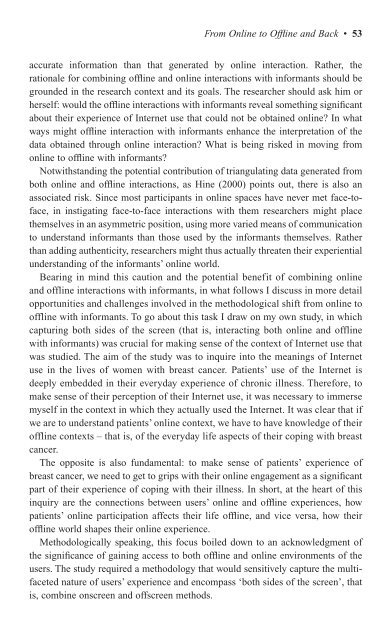Virtual Methods
Virtual Methods
Virtual Methods
You also want an ePaper? Increase the reach of your titles
YUMPU automatically turns print PDFs into web optimized ePapers that Google loves.
From Online to Offline and Back • 53<br />
accurate information than that generated by online interaction. Rather, the<br />
rationale for combining offline and online interactions with informants should be<br />
grounded in the research context and its goals. The researcher should ask him or<br />
herself: would the offline interactions with informants reveal something significant<br />
about their experience of Internet use that could not be obtained online? In what<br />
ways might offline interaction with informants enhance the interpretation of the<br />
data obtained through online interaction? What is being risked in moving from<br />
online to offline with informants?<br />
Notwithstanding the potential contribution of triangulating data generated from<br />
both online and offline interactions, as Hine (2000) points out, there is also an<br />
associated risk. Since most participants in online spaces have never met face-toface,<br />
in instigating face-to-face interactions with them researchers might place<br />
themselves in an asymmetric position, using more varied means of communication<br />
to understand informants than those used by the informants themselves. Rather<br />
than adding authenticity, researchers might thus actually threaten their experiential<br />
understanding of the informants’ online world.<br />
Bearing in mind this caution and the potential benefit of combining online<br />
and offline interactions with informants, in what follows I discuss in more detail<br />
opportunities and challenges involved in the methodological shift from online to<br />
offline with informants. To go about this task I draw on my own study, in which<br />
capturing both sides of the screen (that is, interacting both online and offline<br />
with informants) was crucial for making sense of the context of Internet use that<br />
was studied. The aim of the study was to inquire into the meanings of Internet<br />
use in the lives of women with breast cancer. Patients’ use of the Internet is<br />
deeply embedded in their everyday experience of chronic illness. Therefore, to<br />
make sense of their perception of their Internet use, it was necessary to immerse<br />
myself in the context in which they actually used the Internet. It was clear that if<br />
we are to understand patients’ online context, we have to have knowledge of their<br />
offline contexts – that is, of the everyday life aspects of their coping with breast<br />
cancer.<br />
The opposite is also fundamental: to make sense of patients’ experience of<br />
breast cancer, we need to get to grips with their online engagement as a significant<br />
part of their experience of coping with their illness. In short, at the heart of this<br />
inquiry are the connections between users’ online and offline experiences, how<br />
patients’ online participation affects their life offline, and vice versa, how their<br />
offline world shapes their online experience.<br />
Methodologically speaking, this focus boiled down to an acknowledgment of<br />
the significance of gaining access to both offline and online environments of the<br />
users. The study required a methodology that would sensitively capture the multifaceted<br />
nature of users’ experience and encompass ‘both sides of the screen’, that<br />
is, combine onscreen and offscreen methods.



